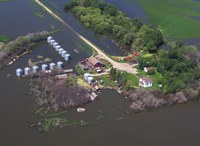Agricultural Losses Due to Flooding Continue in Devil Lake Basin
(Click the image below to view a high-resolution image that can be downloaded)
Potential agricultural earnings continue to be lost in the Devils Lake Basin due to the continued expansion of Devils Lake and Stump Lake.
Estimates show that there will be an increase of more than 10,000 acres of cropland lost to Devils Lake in 2014, according to Jeff Frith, manager of the Devils Lake Basin Joint Water Resource Board, and Bill Hodous, North Dakota State University Extension Service Ramsey County agent.
“Total direct losses are estimated at nearly $57 million due to reduced sales of crop production as a result of inundated acres,” says Dwight Aakre, NDSU Extension Service farm management specialist. “The largest losses are from spring wheat and soybeans, each at about 24 percent of the total. Other crops with major losses include corn, edible beans, barley and canola.”
The total impact on business activity in the region from direct and indirect losses this year is estimated at $209 million, according to Randal Coon, research specialist in the NDSU Agribusiness and Applied Economics Department. These losses include reduced personal income of $55 million and reduced retail trade activity of $46 million. The loss of business activity ultimately is reflected in lost jobs in the region. Secondary employment losses are estimated at 282 jobs for the region.
Lost tax revenues are estimated to be more than $3 million due primarily to a reduction in sales tax revenue. Personal and corporate income taxes also will be reduced.
The data used for the study included the five-year average acreage of each crop grown in the area, five-year average yields for each crop and the estimated 2014 marketing year average price for each crop. The increase in the inundated acreage partially was offset by the lower than expected crop prices for 2014.
This analysis quantifies the extent of the lost agricultural production in the Devils Lake Basin due to the continued high water levels in Devils Lake, Stump Lake and the surrounding area. It does not include any nonagricultural costs associated with roads and other infrastructure.
NDSU Agriculture Communication – May 9, 2014
| Source: | Bill Hodous, (701) 662-7027, bill.hodous@ndsu.edu |
|---|---|
| Source: | Dwight Aakre, (701) 231-7378, dwight.aakre@ndsu.edu |
| Source: | Randal Coon, (701) 231-1018, randall.coon@ndsu.edu |
| Editor: | Rich Mattern, (701) 231-6136, richard.mattern@ndsu.edu |


